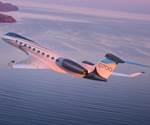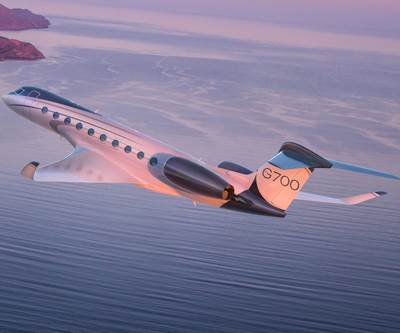Gulfstream unveils G800 and G400 business jets
Ultra-long range G800 and comfortable G400 powered with Pratt & Whitney composite and titanium engines offer operational flexibility and improved environmental performance.

Photo Credit: Gulfstream
Gulfstream Aerospace Corp. (Savannah, Ga., U.S.) a wholly owned subsidiary of General Dynamics (Reston, Va., U.S.), unveiled two new aircraft — the ultra-long range G800 powered by Rolls-Royce Pearl 700 engines, and the G400, its new entrant to the large-cabin class with Pratt & Whitney Canada PW800 powerplant which uses titanium and composite materials — during an event livestreamed on YouTube from the company’s headquarters in Savannah, Ga. The live broadcast also featured a virtual tour of the new G400 and a live reveal of the first G800.
“For more than six decades, Gulfstream has led the business aviation industry with our commitment to continuous improvement and by consistently setting new standards for safety, performance, innovation and comfort,” said Mark Burns, president of Gulfstream, who served as the event’s emcee. “Today marks a major milestone and investment in our company’s future.”
The G800, which will eventually replace the G650ER, offers customers the longest range in the Gulfstream fleet with its 8,000-nautical-mile/14,816-kilometer range at Mach 0.85 and 7,000-nautical-mile/12,964-kilometer range at Mach 0.90. Powered by high-thrust Rolls-Royce Pearl 700 engines and the Gulfstream-designed wing and winglet introduced on the Gulfstream G700, the G800 also features enhanced fuel efficiency and more city-pair capabilities.
The G800 is designed to seat up to 19 passengers and offers up to four living areas or three living areas with crew compartment. It also features the signature Gulfstream cabin experience with 100% fresh, never recirculated air, quiet noise levels, low cabin altitude and 16 Gulfstream panoramic oval windows.
The G400, positioned between the super-midsized G280 and G500, offers a combination of long-range, high-speed performance, cabin comfort and environmental efficiency, according to Gulfstream.
It increases environmental performance by reducing fuel consumption, emissions and noise through its use of Gulfstream’s aerodynamic clean-wing design and advanced Pratt & Whitney PW812GA engines. The aircraft will fly 4,200 nautical miles/7,778 kilometers at its long-range cruise speed of Mach 0.85. Three floorplans are offered, with options for seating up to nine, 11 or 12 passengers, and the G400 also provides the signature Gulfstream cabin experience and 10 Gulfstream panoramic oval windows.
Pratt & Whitney Canada (Longueuil, Quebec) will deliver a fully integrated powerplant solution comprised of the PW812GA engine and nacelle system provided by Collins Aerospace (Charlotte, N.C., U.S.). The PW812GA extends the application of the PW800 architecture, with optimizations for the advanced requirements of the G400 aircraft including the latest full authority digital engine control, sophisticated technology to support engine health monitoring and the use of advanced materials such as titanium and composites to deliver superior performance and availability.

Twin PW812GA engines will power the new Gulfstream G400 aircraft. Photo Credit: Pratt & Whitney
“The G400 was conceived and designed with direct customer input,” said Burns at the live event. “The aircraft re-envisions this market segment with its maximum operational flexibility and enhanced cabin comfort.”
The G400 use composite materials in a number of areas, including WTBF panels; the nose radome; fuselage tail cone; HT skins; upper VT (“Bullet”) cone; upper VT skirt fairings; floor boards; flat pressure bulkhead (partial); aux pressure bulkhead; winglets; apron, nacelle; rudder; several of its access doors; and more. The G800 covers similar items, but retains a metallic aux pressure bulkhead instead of composite. Further, it has composite spoilers on the wing, and composite fixed trailing edges between the aileron and winglet and the inboard part of the flap and fuselage.
Both the G800 and G400 are equipped with the Gulfstream Symmetry flight deck featuring electronically linked active control sidesticks and 10 touchscreen displays.
Additional health and safety enhancements include a plasma ionizing clean air system neutralizing 99.9% of airborne bacteria, spores and odors; and its predictive landing performance system, providing pilots advanced warning of potential runway excursions so they can adjust approaches or go around.
G800 customer deliveries are anticipated to begin in 2023 and G400 deliveries are expected in 2025.
Related Content
The potential for thermoplastic composite nacelles
Collins Aerospace draws on global team, decades of experience to demonstrate large, curved AFP and welded structures for the next generation of aircraft.
Read MoreManufacturing the MFFD thermoplastic composite fuselage
Demonstrator’s upper, lower shells and assembly prove materials and new processes for lighter, cheaper and more sustainable high-rate future aircraft.
Read MorePlant tour: Albany Engineered Composites, Rochester, N.H., U.S.
Efficient, high-quality, well-controlled composites manufacturing at volume is the mantra for this 3D weaving specialist.
Read MoreCryo-compressed hydrogen, the best solution for storage and refueling stations?
Cryomotive’s CRYOGAS solution claims the highest storage density, lowest refueling cost and widest operating range without H2 losses while using one-fifth the carbon fiber required in compressed gas tanks.
Read MoreRead Next
Daher composite-metal winglets enhance performance of new Gulfstream G-700 large-cabin bizjet
The winglets are manufactured at the Daher factory in Tarbes, France and assembled into the aircraft at the Gulfstream’s Savannah plant.
Read MoreAll-recycled, needle-punched nonwoven CFRP slashes carbon footprint of Formula 2 seat
Dallara and Tenowo collaborate to produce a race-ready Formula 2 seat using recycled carbon fiber, reducing CO2 emissions by 97.5% compared to virgin materials.
Read MoreDeveloping bonded composite repair for ships, offshore units
Bureau Veritas and industry partners issue guidelines and pave the way for certification via StrengthBond Offshore project.
Read More

























